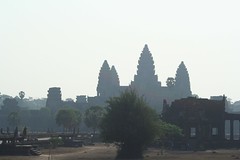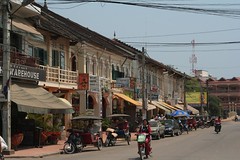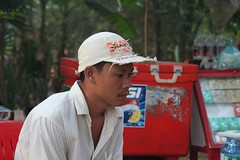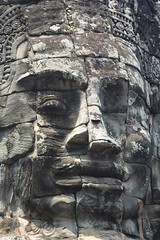
Click photo to see slideshow
or here for all Angkor pictures
Cambodia - the cradle of the powerful Khmer empire in the old days - is a land that has gone through tormented recent times. It slumbered under a brief colonial French rule whose legacy can still be visible today; it achieved independence and survived the Indochina wars almost unscathed; it got its share of civil war between a corrupt western-backed government and ruthless, single-minded communist guerillas and wound up subjected to a horrifying social experiment performed by the genocidal Khmer Rouge. Yet the Cambodians still smile as they go through their days. Lately, after a period of turmoil following the return to monarchy and democracy (for lack of another word to describe the local medley of bickering political parties, military coups, and foreign influence) and the demise of the last Khmer Rouge guerillas, Cambodia’s wounds began to heal slowly. And what could spell “normalcy” better than a steady influx of western tourists and sustained hotel development? In fact, hotel building seems to be at an all-time high those days in Siem Reap, the provincial town used as a base to visit Angkor Wat - possibly the most famous ruin in Asia.
There are many ways to get to the Angkor ruins. You can take an organized tour – if you like to spend your day herded from site to site in an air-conditioned minibus, with a bunch of other clueless tourists, listening to a guide who will probably give you less historical information than your Lonely Planet book; you can rent a bike and pedal your lungs out in the searing heat that descends over the Cambodian plain by 9AM; or you can hire a tuk-tuk driver for the day and visit the sites of your choice at your own pace. Cambodian tuk-tuks are similar to rickshaws, but unlike those, they are built by attaching a two-wheeler passenger cart, seating up to four, to a regular motorbike. In my opinion, the extra comfort of a car is not worth the price increase over a tuk-tuk.
A day-pass for the ruins will set you back $20 (or $40 for the 3-day pass) and you’ll count another $10 or $12 for the driver per day, sunrise to sundown. The three-day pass is the best option. You can’t see everything in one day; the heat will likely send you back to town early, in search of a cool corner and a chilled beer. Angkor Wat and The Bayon may be the most famous and well-preserved of the ancient Khmer temples and they will take a good chunk of your time, but in fact there are enough interesting ruins at Angkor to fill three days of slow-paced exploration, allowing for plenty of down-time to while away the unbearable afternoons. Climbing the worn-out stone stairs, following dirt paths through holy courtyards abandoned to the ruinous vegetation, jumping over giant crumbled masonry blocks brought back memories of our visits to the Mayan cities in Yucatan, almost a year ago. It was the same feeling, the same guilty pleasure of being a dumbfounded spectator to the silent show of broken, wasted glory from a bygone age.
Cambodia doesn’t bother much with the money exchange business; as weak as the dollar is now, it is still the de-facto currency here. Unlike Ecuador - another dollar-based economy - Cambodians have their own money, the riel, but it seems to be mostly used for giving change under a dollar. Almost all prices are quoted in US$: hotel rooms, restaurants, tickets, groceries, museums. If you happen to have riel you can use those interchangeably, at a fixed rate of 4000 to the dollar. ATMs dispense dollars and traveler’s checks are redeemed in the same currency. Tourists are happy to see their buck going a long way – one dollar will get you a plate of fried rice or noodles on the street and most purchases are negotiable. Children try to sell you water and “cold-ish” drinks as soon as you get out of your tuk-tuk and are about to set off eagerly for the ruins, and after you come out, tired and worn out, heading back to your driver. And if you really don’t need another bottle of water beside the two that you’re already carrying in your backpack, you surely need some books, don’t you?
Maybe you want a guide for Angkor Wat, with nice aerial pictures and in-depth historical explanations? No thank you… Maybe you need a Lonely Planet guide for Cambodia, Vietnam or Laos for only 2 dollars? No, thanks… wait! Only two dollars for the most recent Lonely Planet edition!? How is that possible? You take the book in your hand and slowly flip through a few pages. Yes, it’s indeed the last edition and it definitely looks brand new, not a used copy abandoned by a tourist. But there’s something wrong about it, something you can’t identify immediately. It just doesn’t feel like a Lonely Planet book, it doesn’t fit and bend in your hand the same way. And then you suddenly realize – it’s a knockoff copy! Yes, even the photos are printed on glossy paper, but they are less shiny and the colors are rather dull and sometimes off the mark. The photocopied black-and-white text looks just a bit flawed, the maps show grainy bits of grey where the original pattern was too delicate. Some pages are a bit faded, where the toner had started to run out; they are not aligned properly so you can’t see the black markers that delimit the chapters when you look at the book sideways… still, for only two dollars… I have serious objections to buying illegally-copied intellectual property, but if I were traveling in Cambodia, desperately needing a guide book for my next destination I might chop off some of that moral integrity by way of reasoning that my purchase helps the local community...
But we had already bought our genuine Laos LP guide in India, so there was no need to commit a moral crime… Later we realized that it’s not just Lonely Planet guide books that come fresh from the Cambodian printing presses; all the action, mystery and romance bestsellers that tourists usually read on vacation (including the dreadful Davinci Code) were lying on book stands wrapped in plastic, neatly photocopied from the original editions and bound into seemingly-genuine soft covers. On closer inspection they may look just a bit too cheap, but they would do the job just like the originals. Happy reading in Cambodia! Posted from Pakse, Laos - we may not have much internet access for the next few days!









2 comments:
wow! Meth!! Do you by any chance know meth's e-mail? I was in Cambodia in July and Meth drove my friends and I around. I misplaced his card and would really like to contact him. Please, let me know if you have his e-mail. Thanks a bunch.
Silvia
Unfortunately I did not ask for Mr. Meth's email.
If you want to get in touch with him I would start by contacting the hotel Mandalay Inn in Siem Reap - they hired Mr. Meth for us for the day so they may know how to find him. I don't have the inn's email address, but the place is pretty famous online and in travel books.
Good luck
Post a Comment